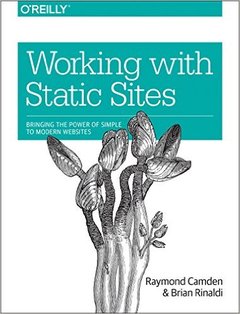Working with Static Sites
Auteurs : Camden Raymond, Rinaldi Brian

Just like vinyl LPs, static sites are making a comeback, evidenced by the wide array of static-site generators now available. This practical book shows you hands-on how to build these simple sites for blogs and other use cases, and how to make them more powerful. In the process, you’ll work with some of today’s more mature and popular static-site generators.
Authors Raymond Camden and Brian Rinaldi explain the advantages of using static-site generators for building fast and secure sites. Web and frontend designers and developers will also explore methods for adding dynamic elements and for migrating an existing CMS to a static site.
- Build a basic four-page static site with the Harp generator
- Create a simple blog with Jekyll
- Develop a documentation site with Hugo by generating site files and creating the layout
- Add dynamic elements, such as forms, comments, and search
- Integrate a CMS with tools such as CloudCannon and Netlify CMS
- Use one of several options to deploy your static files
- Learn methods for moving an existing CMS to a static site
. Benefits of Static Sites
Chapter 2 - Building a Basic Static Site
. Welcome to Harp
. Your First Harp Project
. Working with Layouts and Partials
. Working with Data
. Generating a Site
. Building Camden Grounds
. Going Further with Harp
Chapter 3 - Building a Blog
. Blogging with Jekyll
. Your First Jekyll Project
. Writing a Post
. A Quick Introduction to Liquid
. Working with Layouts and Includes
. Adding Additional Files
. Working with Data
. Configuring Your Jekyll Site
. Generating a Site
. Building a Blog
. Going Further with Jekyll
Chapter 4 - Building a Documentation Site
. Characteristics of a Documentation Site
. Choosing a Generator for Your Documentation Site
. Our Sample Documentation Site
. Creating the Site
. Going Further
Chapter 5 - Adding Dynamic Elements
. Handling Forms
. Adding Comments
. Adding Search
. Even More Options
Chapter 6 - Adding a CM
. CloudCannon
. Netlify CMJekyll Admin
. More Options
Chapter 7 - Deployment
. Plain Old Web Servers
. Cloud File Storage Providers
. Deploying with Surge
. Deploying with Netlify
. Summary
Chapter 8 - Migrating to a Static Site
. Migrating from WordPress to Jekyll
. Other Migration Options
. Go Forth and Be Static
Brian Rinald is the Developer Programs Manager at Telerik focused on ensuring that the Developer Relations team creates top notch content for the web development community on the Telerik Developer Network
Date de parution : 03-2017
Ouvrage de 198 p.
18.1x23.3 cm
Disponible chez l'éditeur (délai d'approvisionnement : 12 jours).
Prix indicatif 44,92 €
Ajouter au panier

